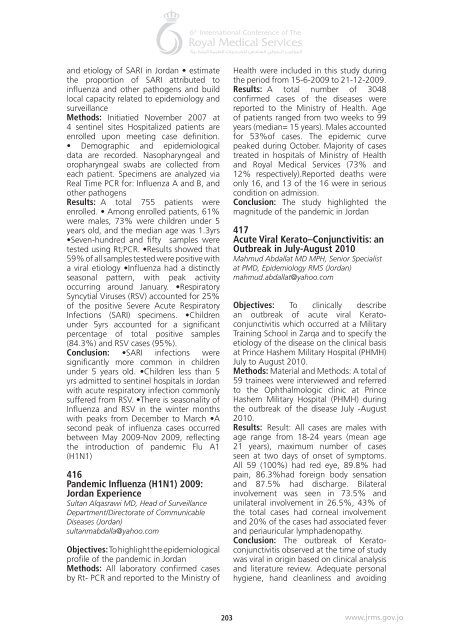Abstract book 6th RMS 16.indd
Abstract book 6th RMS 16.indd
Abstract book 6th RMS 16.indd
You also want an ePaper? Increase the reach of your titles
YUMPU automatically turns print PDFs into web optimized ePapers that Google loves.
and etiology of SARI in Jordan • estimate<br />
the proportion of SARI attributed to<br />
influenza and other pathogens and build<br />
local capacity related to epidemiology and<br />
surveillance<br />
Methods: Initiatied November 2007 at<br />
4 sentinel sites Hospitalized patients are<br />
enrolled upon meeting case definition.<br />
• Demographic and epidemiological<br />
data are recorded. Nasopharyngeal and<br />
oropharyngeal swabs are collected from<br />
each patient. Specimens are analyzed via<br />
Real Time PCR for: Influenza A and B, and<br />
other pathogens<br />
Results: A total 755 patients were<br />
enrolled. • Among enrolled patients, 61%<br />
were males, 73% were children under 5<br />
years old, and the median age was 1.3yrs<br />
•Seven-hundred and fifty samples were<br />
tested using Rt;PCR. •Results showed that<br />
59% of all samples tested were positive with<br />
a viral etiology •Influenza had a distinctly<br />
seasonal pattern, with peak activity<br />
occurring around January. •Respiratory<br />
Syncytial Viruses (RSV) accounted for 25%<br />
of the positive Severe Acute Respiratory<br />
Infections (SARI) specimens. •Children<br />
under 5yrs accounted for a significant<br />
percentage of total positive samples<br />
(84.3%) and RSV cases (95%).<br />
Conclusion: •SARI infections were<br />
significantly more common in children<br />
under 5 years old. •Children less than 5<br />
yrs admitted to sentinel hospitals in Jordan<br />
with acute respiratory infection commonly<br />
suffered from RSV. •There is seasonality of<br />
Influenza and RSV in the winter months<br />
with peaks from December to March •A<br />
second peak of influenza cases occurred<br />
between May 2009-Nov 2009, reflecting<br />
the introduction of pandemic Flu A1<br />
(H1N1)<br />
416<br />
Pandemic Influenza (H1N1) 2009:<br />
Jordan Experience<br />
Sultan Alqasrawi MD, Head of Surveillance<br />
Department/Directorate of Communicable<br />
Diseases (Jordan)<br />
sultanmabdalla@yahoo.com<br />
Objectives: To highlight the epidemiological<br />
profile of the pandemic in Jordan<br />
Methods: All laboratory confirmed cases<br />
by Rt- PCR and reported to the Ministry of<br />
Health were included in this study during<br />
the period from 15-6-2009 to 21-12-2009.<br />
Results: A total number of 3048<br />
confirmed cases of the diseases were<br />
reported to the Ministry of Health. Age<br />
of patients ranged from two weeks to 99<br />
years (median= 15 years). Males accounted<br />
for 53%of cases. The epidemic curve<br />
peaked during October. Majority of cases<br />
treated in hospitals of Ministry of Health<br />
and Royal Medical Services (73% and<br />
12% respectively).Reported deaths were<br />
only 16, and 13 of the 16 were in serious<br />
condition on admission.<br />
Conclusion: The study highlighted the<br />
magnitude of the pandemic in Jordan<br />
417<br />
Acute Viral Kerato–Conjunctivitis: an<br />
Outbreak in July-August 2010<br />
Mahmud Abdallat MD MPH, Senior Specialist<br />
at PMD, Epidemiology <strong>RMS</strong> (Jordan)<br />
mahmud.abdallat@yahoo.com<br />
Objectives: To clinically describe<br />
an outbreak of acute viral Keratoconjunctivitis<br />
which occurred at a Military<br />
Training School in Zarqa and to specify the<br />
etiology of the disease on the clinical basis<br />
at Prince Hashem Military Hospital (PHMH)<br />
July to August 2010.<br />
Methods: Material and Methods: A total of<br />
59 trainees were interviewed and referred<br />
to the Ophthalmologic clinic at Prince<br />
Hashem Military Hospital (PHMH) during<br />
the outbreak of the disease July -August<br />
2010.<br />
Results: Result: All cases are males with<br />
age range from 18-24 years (mean age<br />
21 years), maximum number of cases<br />
seen at two days of onset of symptoms.<br />
All 59 (100%) had red eye, 89.8% had<br />
pain, 86.3%had foreign body sensation<br />
and 87.5% had discharge. Bilateral<br />
involvement was seen in 73.5% and<br />
unilateral involvement in 26.5%, 43% of<br />
the total cases had corneal involvement<br />
and 20% of the cases had associated fever<br />
and periauricular lymphadenopathy.<br />
Conclusion: The outbreak of Keratoconjunctivitis<br />
observed at the time of study<br />
was viral in origin based on clinical analysis<br />
and literature review. Adequate personal<br />
hygiene, hand cleanliness and avoiding<br />
203 www.jrms.gov.jo

















